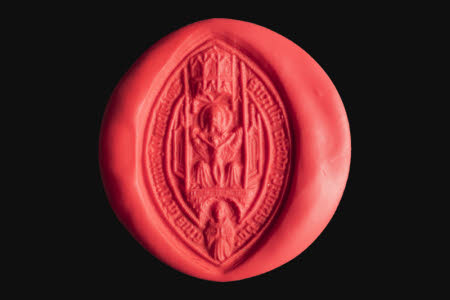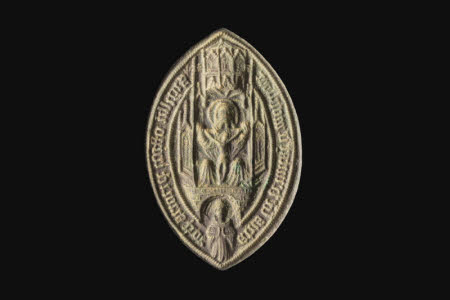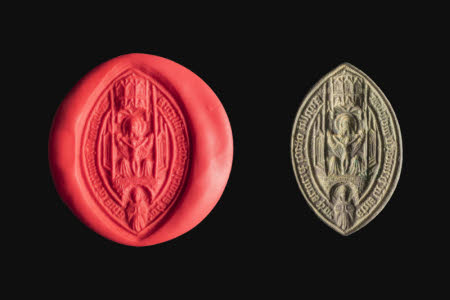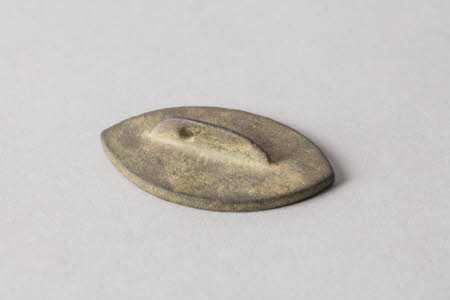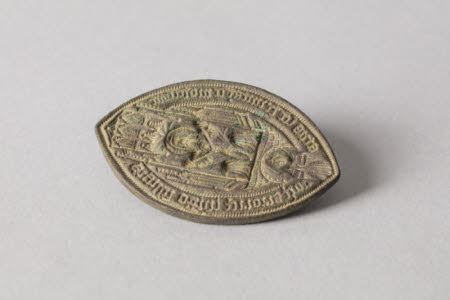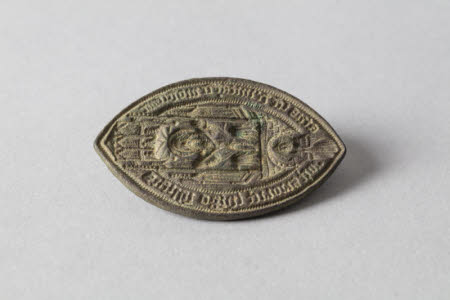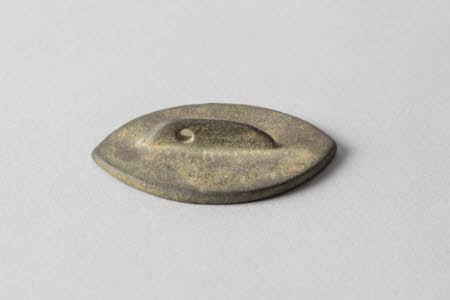Seal matrix
Category
Archaeological material
Date
1470 - 1520
Materials
Copper-Alloy
Measurements
60 x 40 mm; 50.08 g (weight)
Place of origin
England
Order this imageCollection
Mottisfont, Hampshire
NT 1954778
Summary
Complete medieval cast copper-alloy seal matrix attributed to the Priory at Mottisfont, Hampshire. Pointed oval (vesica) shape, depicting the Holy Trinity in the form of a robed and enthroned figure of God the Father, who is then holding a crucified Christ, the son. The dove of the Holy Spirit present above the left shoulder. Beneath this depiction of the Trinity and separated from the upper portion by a stone arch, is a demi-figure of a praying cleric facing towards the person sealing. The matrix has the legend sigillu[m] officii prioris p[ri[oretas sce trinitat[is] de Motesfont (Seal of the Official of the Prior of the Priory of Mottisfont) Flat to reverse, with a projecting flange pierced for suspension. English, c.1470-1520.
Full description
In the medieval period it was common for documents to be sealed with a wax impression. These seals could represent an individual or an organisation and by being added to a document they certified their agreement to it. They were made by pouring hot wax onto the document and then pressing down a matrix seal like this one to make an impression in the wax which would then cool and dry. Sometimes the wax could be attached to a strip of parchment extended from the document or the wax attached to the document by cords. The seal is inscribed in Latin, sigillu[m] officii prioris p[ri]oretas sce trinitat[is] de Motesfont. The square brackets in the Latin are for the extensions of the abbreviations. The legend also has contraction marks over the -u and the -ce and the "C" is an orthographic variant of "s" with "sce" being an abbreviation for Sancte. The legend can be translated as Seal of the Official of the Prior of the Priory of Mottisfont marking its association with the medieval priory at Mottisfont. Founded by William Brewer (1145-1226) in 1201, Mottisfont Priory lasted until it was dissolved during the reign of Henry VIII when it was purchased by William, 1st Baron Sandys (c.1470-1540). who then converted the buildings into a private house. An institution like Mottisfont Priory would have had a single seal to authenticate documents on its behalf. There is one known wax example of Mottisfont Priory’s seal which is placed on a document held at the National Archives, Kew Gardens, London [The National Archives, Kew, DL 27/232]. The impression bears many similarities to this seal matrix as they both illustrate the Priory’s dedication to the Holy Trinity, with images of God the Father, Christ the Son, and the Holy Spirit prominently displayed. However, the example in the National Archives does not include the image of a kneeling cleric which is found on this seal matrix. Official seal matrices for important institutions such as a priory would be well-made, individually-crafted pieces, probably hand-tooled by a master craftsperson. In contrast, this example is relatively crudely made, and it is probable that the object has been cast, rather than engraved. This suggests that it may have been produced in multiple numbers, rather than as a unique piece for use only by the Prior. This is supported by the translation of the inscription, which makes it clear that it is for the use of an official, rather than the prior himself. Beyond this, however, the legend does not make the matrix's use clear. However, it was common for medieval Religious Houses such as Mottisfont to raise funds through the sales of indulgences, or letters of confraternity. These transactions were confirmed by sealed documents and in many cases had specific matrixes which were used for this purpose and there are surviving examples for both related to the Hospital at Burton Lazar, Leicestershire. There is no evidence that Mottisfont Priory ever sold confraternities, however, it was granted the right to sell indulgences on two occasions in 1353 and 1457 and it is most likely therefore, that this matrix was used to confirm the sale of indulgences for Mottisfont Priory. The stylistic dating of the seal to the period 1470-1520 makes it likely it is associated with the second granting of indulgences by the Pope in 1457. Indulgences developed in the Catholic Church around the concept of penance for sinful acts and deeds. By the 13th and 14th centuries they were increasingly used by church institutions for fundraising purposes, often for large building projects. Pardoners, men who travelled round selling indulgences on behalf of these institutions, became common too – with a pardoner being one of Chaucer’s characters in The Canterbury Tales. But as more and more money was raised, so accusations of corruption grew, with the sale of indulgences being a factor in the Protestant Reformation, with Martin Luther’s Ninety-Five Theses directly criticising the practice. The extent to which Mottisfont sold these indulgences is unknown. Some medieval religious houses sent pardoners across the country, presumably equipped with their own seals to raise funds for their institution. This example, was, however, discovered within 2 miles of the location of Mottisfont Priory, in the parish of Lockerley, Hampshire [PAS HAMP-CE0EE2]. From 1271, royal permission was granted for a weekly market and annual fair in the parish, and it is possible that the discovery of the matrix seal in this area could reflect the monks at Mottisfont selling their pardons at these events.
Provenance
Discovered by metal detector in the parish of Lockerley, Hampshire [Portable Antiquities Scheme HAMP-CE0EE2] 2021; Purchased by the National Trust at Timeline Auctions in February 2022.
References
Roberts and Cherry 2024: George Roberts and John Cherry, 'The Seal Matrix of the Office of the Prior of Mottisfont Priory, Hampshire', Hampshire Studies, 79, 2024, pp.143-147. Ellis 1986: Roger H. Ellis, Catalogue of Seals in the Public Record Office; Monastic Seals: Volume 1, London, 1986 Marcombe 2008: David Marcombe, ‘The Seals of the Order of St Lazarus of Jerusalem in England’, in Noel Adams, John Cherry & James Robinson (eds.), Good Impressions: Image and Authority in Medieval Seals, London, 2008, pp.52-59 Doubleday and Page 1903: H. Arthur Doubleday and William Page (eds.), A History of the County of Hampshire; Volume 2, London: Victoria County History, 1903, pp.172-175 Clark-Maxwell 1926: William Gilchrist Clark-Maxwell, ‘Some Letters of Confraternity’, Archaeologia, 75 1926, pp.19-60 Clark-Maxwell 1929: William Gilchrist Clark-Maxwell, ‘Some Further Letters of Fraternity’, Archaeologia, 79 1929, pp.179-216

